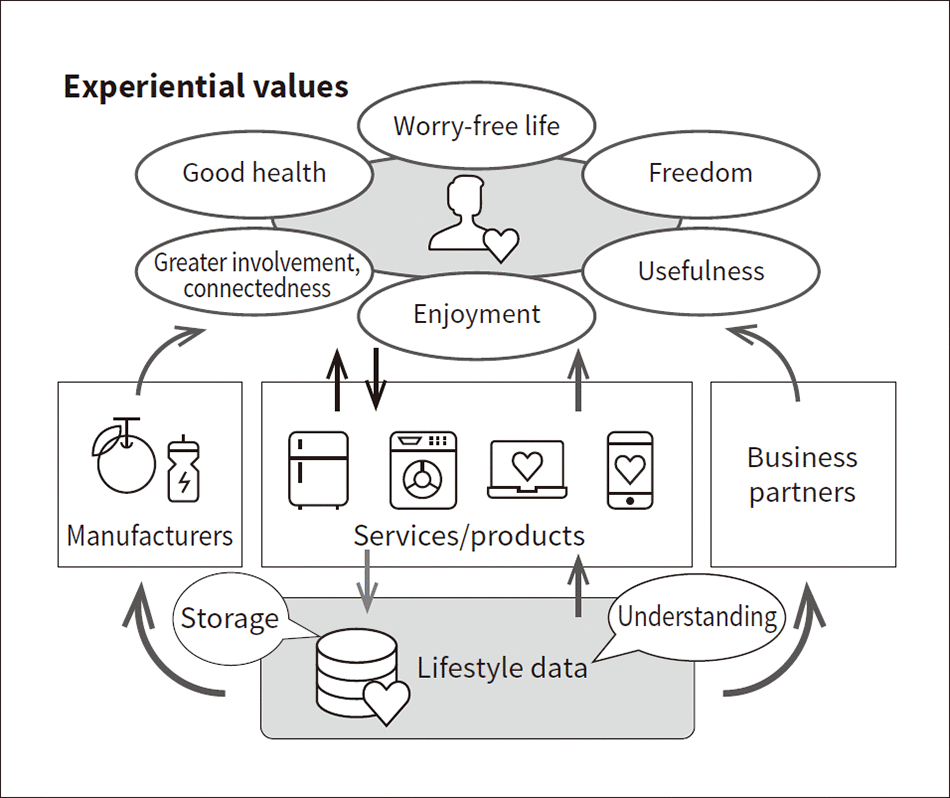Smart Life Solutions that Improve Quality of Life by Solving Societal and Lifestyle IssuesPeloridge Social Media Service for FoodE2E Service Linking Hitachi with its Customers
Highlight
Today’s increasingly diverse lifestyles, more sophisticated distribution methods, and rapidly growing volume of food-related information are making consumers more interested in good food and healthy eating. Hitachi Global Life Solutions, Inc. is working on providing Smart Life Services that create new user value by matching individual lifestyles and life changes. One example is Peloridge, a food-related social media service the company has started to help solve food issues and improve food satisfaction.

1. Introduction
Fig. 1—Providing Smart Life Services Understanding lifestyle data helps improve experiential values for consumers.
Understanding lifestyle data helps improve experiential values for consumers.
The subject of food has recently been associated with a wide range of issues of public concern such as food loss, food safety, counterfeit food, and contamination. At the same time, today’s increasingly diverse lifestyles and more sophisticated distribution methods have generated a large amount of food-related lifestyle information that is making consumers more interested in good food and healthy eating.
Since the home appliance businesses of Hitachi Global Life Solutions, Inc. (Hitachi GLS) have spent many years working on improving consumer quality of life (QoL), the company has decided to work on reducing food loss in the home (helping solve an issue of public concern) and improving consumer food satisfaction. The company wants to provide Smart Life Services that enrich consumer lives by using lifestyle data such as consumer interests and preferences to identify needs and insights, and by working with partners and its own products and services (see Figure 1).
2. Food Areas of Focus
Figure 2 illustrates the value chain for food processes. By providing home appliances such as refrigerators, microwave ovens, and rice cookers, Hitachi GLS has provided value in the food domain for many years in the form of storage and cooking processes. Over the years, housework chores have been assisted by labor-saving devices made possible by mechanization and automation, while greater functionality and performance have saved time and energy. More recently, the development of connected appliances that connect to the Internet has enabled exchanges of recipe data and other refinements that create more convenient and highly functional home appliances.
But with consumer lifestyles and values diversifying, it is important to identify insights into consumers to meet their widely varying needs. To do so, the company created the Peloridge social media service as an information tool that covers both of the processes the company feels are most important for understanding the eating habits of consumers—the starting point processes (discovering and becoming interested in food, devising recipes) and the food preference process (presenting and eating food). Peloridge provides users with food-related information and stimulates communication among users. By using the insight information generated by these activities, it also aims to help with further improving home appliance functionality and with providing new services.
Fig. 2—Food Value Chain and Areas Covered by Peloridge The areas of user assistance handled by conventional products (home appliances) and services (Peloridge) are expanding, creating a value chain that contributes to Smart Life Services.
The areas of user assistance handled by conventional products (home appliances) and services (Peloridge) are expanding, creating a value chain that contributes to Smart Life Services.
3. Peloridge
Based on the concept of “Discovering New Great Food,” Peloridge is a smartphone app that lets users update their lifestyle through various types of personal knowledge and stories about food (ingredients, foods). Users can discover new ingredients and foods, save favorite products, and learn and discuss recommended eating methods or habits, reasons for selecting particular foods, and various other personal stories about ingredients and foods. For example, the app is designed for communication such as between mothers in the ‘active senior’ demographic and their daughters to whom they want to pass along their memories and flavors, and sharing information about favorite ingredients and foods with people in environments similar to their own.
3.1 Peloridge Functions
The functions of Peloridge are described below (see Figure 3).
- Easily discover good foods
Users can display posts containing their favorite keywords, making it easy to discover new ingredients or foods, or find cooking tips and advice. - Find stories about good foods
Users can find everything from handy hints on making appealing dishes to food stories recalling flavors and more from the people they admire or people of various interests and preferences. - Save stories about good foods
Users can write posts about dishes they have made themselves or about recommended ingredients or food items. When favorite posts are found, they can be saved on a user page using the ‘Clip’ button. - Share good foods
Users can leave comments on posts of interest they have found, enabling them to share favorite foods with various types of people.
Fig. 3—Peloridge Functions Peloridge uses typical social media service functions such as posting and commenting as a foundation for providing functions that let users share various information and experiences about good food.
Peloridge uses typical social media service functions such as posting and commenting as a foundation for providing functions that let users share various information and experiences about good food.
3.2 Peloridge Activities
The aim of Peloridge is to let users who specialize in particular types of foods or eating habits get together on the app to form communities for deeper interactions, making it easier for users to discover appealing new food experiences through these communities.
For dual-income households and households with growing children for example, the app provides rapid access to information of interest by creating the categories ‘Easy,’ ‘Time-saving,’ and ‘Make it for later,’ and displaying all the related posts together there.
The app also helps users experience foods through special events involving giveaways of trendy or unusual foods.
These activities create a user base divided into segments of people with similar lifestyles, interests, or preferences.
4. Creation of Service Businesses
When creating service businesses, the company used the processes below in the service design. The aim was to create digital service businesses with a concept described by the following keywords—consumer starting point, latent needs, speed launch, continual updates.
4.1 Service Design Processes
Service design rooted in experiential value is usually handled by the processes below.
- Understanding the business environment
Gaining a deeper understanding of the outside environment and the company’s own environment, and a deeper understanding of the activities to aim for - Understanding users
Using the results of user surveys to determine the user image (persona); deriving consumer expectations and needs by identifying consumer behaviors and feelings - Researching service proposals
Presenting proposals for services that contribute value in response to user expectations and needs; depicting future experiences - Concretizing implementation methods
Listing the items needed to implement the service and the challenges for providing it; holding workshops to brainstorm and edit service ideas
The design work was begun by having a team of 21 members selected from within the company depict experiences of value to consumers, and researching services from the viewpoint of consumers. The team then came up with a list of over 100 ideas for meeting a wide range of needs in all areas of life. This list was then edited down to about 10 ideas, and user stories were created for each. Business feasibility was assessed to determine whether each idea would be possible, competitive, and profitable. The initial concept the team devised as a result was a refrigerator-based communication service enabling easy and simple creation of data about ingredients in the refrigerator, expanding communication with family and friends. The service would aim to improve the convenience and quality of daily life.
The team then performed a survey on the value provided by the service. They found the respondents were more interested in people resembling themselves or people they admire than the content of their refrigerators. The team responded by changing the service concept to ‘ingredient and food stories from various types of people’ as a way to make the service more approachable for users and increase the value it would provide through information.
After this concept refinement, the service was given the name Peloridge to express its concept and approachability. The name comes from the Japanese pelori (a word describing enthusiastic eating) and ‘fridge’ (refrigerator, the edge point or point of contact).
4.2 Application Development
The company felt that social media service development requires user assessment and experience as soon as possible to gauge the value provided by the service, so it decided to release a minimum viable product followed by a rapid series of application improvements and function additions. The agile approach was therefore selected as the development method, with a development cycle driven by releases of about one update per month. While this development cycle is extremely fast compared to the product development done by conventional product business segments, the company is keeping to it out of an awareness of the importance of rapidly feeding back user needs and insights into the service.
Once the Peloridge service was released, users who experienced it were surveyed to identify issues with the customer experience and user experience to improve and refine the point of client contact.
5. Conclusions
Food is a familiar subject often associated with the happiest moments of consumers’ daily lives and life histories. Peloridge is a new point of contact between Hitachi GLS and consumers that helps improve consumer QoL by providing close contact with each individual, and giving users exciting food information discoveries and experiences.
As conventional home appliances evolve into connected appliances, machine data and consumer lifestyle data are starting to be acquired. In addition to the information obtained from connected appliances, food-related social media services can also acquire information such as consumers’ dietary interests, preferences, behaviors, and changes. The lifestyle data obtained by expanding food process-based points of contact with consumers will be analyzed by Hitachi GLS to gain a deeper understanding of consumers that will let it improve consumer food satisfaction and help provide solutions to issues such as reducing household food loss.
Hitachi GLS sees significant business opportunities for collaborations with partner companies such as food producers, processors, and distributors. Using Peloridge users as a base, the company wants to expand business opportunities through collaborative creation projects such as providing advertising methods or direct sales channels, or developing new products or services.








